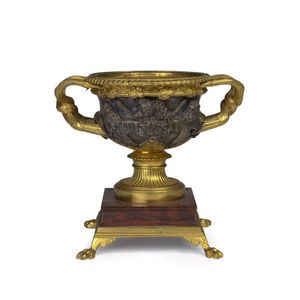Victorian Sterling Silver Warwick Vase by Benjamin Smith II
You must be a subscriber, and be logged in to view price and dealer details.
Subscribe Now to view actual auction price for this item
When you subscribe, you have the option of setting the currency in which to display prices to $Au, $US, $NZ or Stg.
- Krater - A Greek krater is a large vessel that was used in ancient Greece for mixing wine and water. The word "krater" comes from the Greek word "kraino," which means "to mix." In ancient Greece it was considered bad form to drink undiluted wine.
Kraters were used in symposia, or Greek drinking parties, where they were placed in the centre of the room and used to mix wine with water. The mixture was then poured into individual cups and served to the guests.
Kraters were often elaborately decorated with scenes from mythology or daily life, and could be made from a variety of materials, including ceramic, bronze, and marble.
There were several different types of kraters in ancient Greece, and they can be grouped according to the shape of the two handles, or of the vessel itself:- A Volute krater has handles shaped like the volutes on an Ionic capital, whereas a column krater has columnar handles.
- A calyx krater is shaped flower bud, while a bell krater is shaped like a bell.
- Victorian Period - The Victorian period of furniture and decorative arts design covers the reign of Queen Victoria from 1837 to 1901. There was not one dominant style of furniture in the Victorian period. Designers used and modified many historical styles such as Gothic, Tudor, Elizabethan, English Rococo, Neoclassical and others, although use of some styles, such as English Rococo and Gothic tended to dominate the furniture manufacture of the period.
The Victorian period was preceded by the Regency and William IV periods, and followed by the Edwardian period, named for Edward VII (1841 ? 1910) who was King of the United Kingdom and the British Dominions and Emperor of India for the brief period from 1901 until his death in 1910. - Bacchus Motif - The Bacchus motif is a design that features the Roman god Bacchus, who is the god of wine, parties, and celebration. Bacchus is often depicted as a young man with long hair and a beard, holding a bunch of grapes or a wine cup. The Bacchus motif is often used in art and design as a symbol of abundance, revellery, and enjoyment. It can be found on a variety of decorative items, including glassware, ceramics, and other home decor items. The Bacchus motif represents the joy and celebration that can be found in social gatherings and the pleasures of good food and drink.
- Sterling Silver - Sterling silver is a mixture of 92.5% pure silver and 7.5% of another metal, usually copper. Fine silver is 99.9% pure silver, and is relatively soft and the addition of the very small amount of copper gives the metal enough strength and hardness to be worked into jewellery, decorative and household objects.
- Engraving - The method of decorating or creating inscriptions on silver and other metal objects by marking the surface with a sharp instrument such as a diamond point or rotating cutting wheel.
This item has been included into following indexes:
Visually similar items

Ferdinand Barbedienne French cast bronze copy of the Warwick vase having typical Roman features, vine tree like handles, with a copper insert bowl, marked to the base. Condition: good, some wear consistent with age, height 23 cm

An ormolu and bronze urn mounted on a rouge marble base, elaborately decorated with classical images, 20 cm high

A Chamberlain's Worcester urn, early 19th century twin snake handled, on platform base, maroon ground with gilt highlights, hand painted boating scene, unsigned, 20.5 cm high, (one handle repaired)

A French 19th century ormolu mounted bronze centre bowl on marble stand, with Sun King moulded roundel to well, 45 cm width
